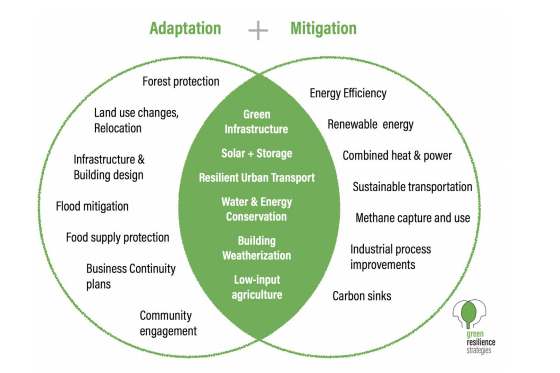How is Resilience related to Sustainability, Mitigation, and Adaptation?
April 29, 2021
Avery Sherffius and Smita Chandra Thomas
The Oxford dictionary defines resilience as “the capacity to recover quickly from difficulties”. This year’s Montgomery County Energy Summit focuses on resilience within the context of commercial, multi-family, and residential built environments. How is resilience related to other terms such as sustainability, mitigation, and adaptation?

Figure 1. Resilience versus Sustainability and the United Nations goals. Adapted from Echotape (2018)
SUSTAINABILITY is best defined by the UN’s 1987 World Commission on Environment and Development, as “to meet the needs of the present without compromising the ability of future generations to meet their own needs”. There are many different ways of achieving that goal, but one of the biggest is an emphasis on renewable resources. Fossil fuels, or anything that the earth has a finite amount of, cannot be considered sustainable because the use of them today impedes future generation’s ability to rely on them. In buildings, Net Zero homes are a cornerstone of sustainability, as they do not produce emissions, and therefore do not compromise the environment for the next generation. Recycled materials offer another sustainable strategy. Green building certifications like LEED and EDGE indicate the level of sustainability of a building that reduces its negative impact on the environment.
RESILIENCE in the context of building structures and communities refers to the ability to continue functioning or recover quickly in the face of some chronic or sudden external failure such as water shortage, power outage, or a natural disaster. While achievements like a green building certification or Net-Zero are important for a sustainable building, they do not necessarily imply resilience. Resilience instead refers to the ability of a building or environment to achieve self-sufficiency, such as through the use of solar panels or generators, or in its water supply systems in case of external failure. A typical backup battery is one example that makes a building resilient but is not considered sustainable because of its negative environmental impacts.
Along the same lines, although there is much overlap between resilient and energy-efficient features, it is important to note that a “resilient building” does not mean the same thing as an energy-efficient building. Efficiency would refer to the ability to use resources with minimal waste, while resilience would refer to being able to produce or maintain resources internally. Think of resilience as an indicator of how well a system responds to shock and recovers from natural hazards or human-induced threats.

Figure 2. Climate Adaptation and Mitigation Synergies. Green Resilience Strategies (2017). Graphic concept modified with acknowledgement of David Macleod, City of Toronto.
MITIGATION strategies for buildings and communities commonly refer to avoiding risks in the construction/development stage, as well as reducing or eliminating potential hazards for the future. Per Frez Wagner, Vice President of the Graham Company, “The stringent LEED credit system offers designers and contractors the guidance they need to produce a sustainable facility, but with those credits also comes safety concerns that must be addressed in order to avoid costly insurance claims.” In essence, mitigation helps achieve a goal, such as a green building certification, with as few potential hazards as possible. For example, Wagner points out that LEED credits can be obtained by reusing materials, but it is important to make sure a reused material does not contain anything hazardous, like lead paint. Actions like this in the development stage are critical components of risk mitigation, which contribute to the resilience of a building. There is overlap between these concepts where not all risk mitigation actions may be aimed at resilience, but many mitigation measures will improve the resilience of a building.
ADAPTATION in the context of buildings was explained in a 2020 journal article funded by the Canadian Department of Civil and Environmental Engineering as “a range of construction activities that improve existing building conditions and extend the effective lives of buildings. The scopes of building adaptation projects vary, and may include rehabilitating failing buildings, improving environmental performances, and changing functional uses.” Of the terms discussed here, adaptation most closely relates to resilience. Similar to resilience, adaptation is often used in the context of a building’s “Plan B”; how fast it can adapt to change or serve multiple utility functions. The key difference between the two is that resilience refers to a more preemptive decision by the architect while adaptation implies a retroactive nature. In essence, a resilient building is designed to sustain itself in the face of obstacles while an adaptable building can be modified to meet those challenges.
References:
Brundtland, G. H. (1987). Report of the World Commission on environment and development: “our common future.” New York: United Nations.
Building adaptation in CONSTRUCTION -Objectives, Importance. (2017, September 05). Retrieved February 17, 2021, from https://theconstructor.org/building/building-adaptation-construction/17792/#:~:text=Adaptation%20means%20the%20ability%20to,the%20performance%20of%20the%20building.
Burroughs, S. (n.d.). Australian Resilience Measurement Scheme (ARMS): A proposed tool for assessing building resilience. Lecture presented in University of Canberra.
Shahi, S., Esnaashary Esfahani, M., Bachmann, C., & Haas, C. (2020). A definition framework for building adaptation projects. Sustainable Cities and Society, 63, 102345. doi:10.1016/j.scs.2020.102345
Wagner, F. (2009, November 02). Risk mitigation in green building. Retrieved February 17, 2021, from https://www.constructionbusinessowner.com/green/risk-mitigation-green-building
Why building resilience is the future of sustainable building. (2018, December 13). Retrieved February 17, 2021, from https://www.echotape.com/blog/why-building-resilience-is-the-future-of-sustainable-building/